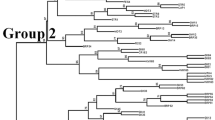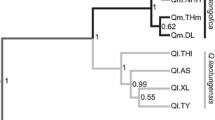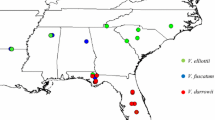Abstract
Microsatellites (simple sequence repeats [SSRs]) are highly variable molecular markers that are a rich and readily assayed source of variation for population genetic studies. Cross-amplification between closely related species is possible when there are no (or few) sequence differences in the primer binding sites. The occurrence of nonhomologous fragments of the same size (size homoplasy) is a contraint of microsatellites. Size homoplasy can be caused by insertions/deletions (indels) in SSR flanking regions. We found that size variation in locus ssrQZAG9 is due to different repeat numbers of the SSR motifs but also to indels in SSR flanking regions. Indels were found within species belonging to sectionsRobur andCerris of genusQuercus and also between species of the 2 sections. In sectionRobur (Quercis robur L.,Quercus petraea [Matt.] Liebl.,Quercus pubescens Willd.), we detected rare alleles with an indel of 57 bp or 62 bp followed by a smaller indel of 12 bp in the SSR flanking regions. These alleles show a size range overlapping with that of alleles amplified inQuercus cerris L. (sectionCerris). Multiple alignments with sequences of sectionRobur revealed the same SSR repeat motif but multiple indels in SSR flanking regions inQ. cerris. We discuss the effects of size homoplasy of SSR loci for the study of interspecific gene flow and on estimates of population differentiation.
Similar content being viewed by others
Abbreviations
- indel:
-
insertion/deletion
- PCR:
-
polymerase chain reaction
- SNP:
-
single nucleotide polymorphism
- SSR:
-
simple sequence repeat
References
Adams RI, Brown KM, and Hamilton MB (2004) The impact of microsatellite electromorph size homoplasy on multilocus population structure estimates in a tropical tree (Corythophora alta) and an anadromous fish (Morone saxatilis). Mol Ecol 13: 2579–2588.
Angers B and Bernatchez L (1997) Complex evolution of a salmonid microsatellite locus and its consequences in inferring allelic divergence from size information. Mol Biol Evol 14: 230–238.
Estoup A, Jarne P, and Cornuet JM (2002) Homoplasy and mutation model at microsatellite loci and their consequences for population genetics analysis. Mol Ecol 11: 1591–1604.
Down BD and Ashley MV (1998) High levels of gene flow in burr oak revealed by paternity analysis using microsatellite. J Hered 89: 62–70.
Hall TA (1999) BioEdit: a user-friendly biological sequence alignment editor and analysis program for Windows 95/98/NT. Nucleic Acids Symp Ser 41: 95–98.
Hancock JM (1999) Microsatellites and other simple sequences: genomic context and mutational mechanisms. In: Goldstein DB and Schlötterer, C (eds) Microsatellites: Evolution and Applications, pp 1–9, Oxford University Press, Oxford, UK.
Krüssmann G (1978) Handbuch der Laubgehölze, pp 79–115, Paul Parey Verlag, Berlin.
Litt M and Luty JA (1989) A hypervariable microsatellite revealed by in vitro amplification of a dinucleotide repeat within the cardiac muscle actin gene. Am J Hum Genet 44: 397–401.
Palop M, Palacios C, and Gonzales-Candelas F (2000) Development and across-species transferability of microsatellites markers in the genusLimonium (Plumbaginaceae). Conserv Genet 1: 177–179.
Petit RJ, Csaikl U, Bordacs S, Burg K, Coart E, Cottrell J, van Dam B, Deans JD, Glaz I, Dumolin-Lapègue S, and others (2002) Chloroplast DNA variation, in European white oaks: phylogeography and patterns of diversity based from data from over 2600 populations. Forest Ecol Manage 156: 5–26.
Sanger FS, Nicklen S, and Coulson AR (1977) DNA sequencing with chain terminating inhibitors. Proc Natl Acad Sci USA 74: 5463–5467.
Slatkin M (1995) A measure of population subdivision based on microsatellite allele frequencies. Genetics 139: 457–462.
Steinkellner H, Fluch S, Turetschek E, Lexer C, Streiff R, Kremer A, Burg K, and Glössl J (1997a) Identification and characterization of (GA/CT)n-microsatellite loci fromQuercus petraea. Plant Mol Biol 33: 1093–1096.
Steinkellner H, Lexer C, Turetschek E, and Glössl J (1997b) Conservation of (GA)n microsatellite loci betweenQuercus species. Mol Ecol 6: 1189–1194.
Tautz D (1989) Hypervariablity of simple sequences as a general source of polymorphic DNA markers. Nucleic Acids Res 17: 6463–6471.
Thompson JD, Higgins DG, and Gibson TJ (1994) CLUSTAL W: improving the sensitivity of progressive multiple alignment through sequence weighting, position specific gap penalties, and weight matrix choice. Nucleic Acids Res 22: 4673–4680.
Vornam B, Decarli N, and Gailing O (2004) Spatial distribution of genetic variation in a natural beech stand (Fagus sylvatica L.) based on microsatellite markers. Conserv Genet 5: 561–570.
Weber JL and May PE (1989) Abundant class of human DNA polymorphism which can be typed using the polymerase chain reaction. Am J Hum Genet 44: 388–396.
Weber JL and Wong C (1993) Mutation of human short tandem repeats Hum Mol Genet 2: 1123–1128.
Author information
Authors and Affiliations
Rights and permissions
About this article
Cite this article
Curtu, AL., Finkeldey, R. & Gailing, O. Comparative sequencing of a microsatellite locus reveals size homoplasy within and between european oak species (Quercus spp.). Plant Mol Biol Rep 22, 339–346 (2004). https://doi.org/10.1007/BF02772677
Published:
Issue Date:
DOI: https://doi.org/10.1007/BF02772677




